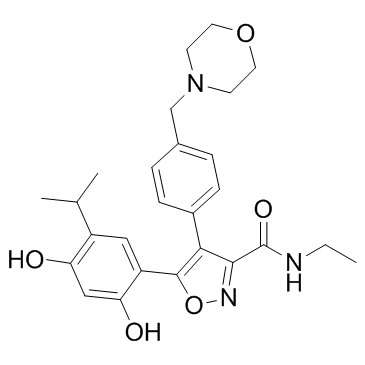747412-49-3
| Name | luminespib |
|---|---|
| Synonyms |
VER-52296
NVP-AUY-922 5-(2,4-dihydroxy-5-isopropylphenyl)-4-(4-morpholin-4-ylmethylphenyl)isoxazole-3-carboxylic acid ethylamide 5-[2,4-dihydroxy-5-(propan-2-yl)phenyl]-N-ethyl-4-[4-(morpholin-4-ylmethyl)phenyl]-1,2-oxazole-3-carboxamide 3-Isoxazolecarboxamide, 5-[2,4-dihydroxy-5-(1-methylethyl)phenyl]-N-ethyl-4-[4-(4-morpholinylmethyl)phenyl]- LUMINESPIB 5-(2,4-Dihydroxy-5-isopropylphenyl)-N-ethyl-4-[4-(4-morpholinylmethyl)phenyl]-1,2-oxazole-3-carboxamide 5-[2,4-Dihydroxy-5-isopropylphenyl]-N-ethyl-4-[4-(4-morpholinylmethyl)phenyl]-3-isoxazolecarboxamide NVP-AUY922 AUY 922 |
| Description | Luminespib (NVP-AUY922) is a potent HSP90 inhibitor with IC50s of 7.8 and 21 nM for HSP90α and HSP90β, respectively. |
|---|---|
| Related Catalog | |
| Target |
HSP90α:7.8 nM (IC50) HSP90β:21 nM (IC50) GRP94:535 nM (IC50) TRAP-1:85 nM (IC50) |
| In Vitro | Luminespib is a potent and selective HSP90 inhibitor, with IC50s and Kis of 21 ± 16, 8.2 ± 0.7 nM against HSP90β and of 7.8 ± 1.8, 9.0 ± 5.0 nM for HSP90α. Luminespib shows weak activity against GRP94 and TRAP-1 wich IC50s of 535 ± 51 nM (Ki, 108 nM) and 85 ± 8 nM (Ki, 53 nM), respectively. Luminespib exhibits inhibitory effect on proliferation of various human tumor cell lines (2.3-49.6 nM), induces cell cycle arrest and apoptosis and depletes client proteins in human cancer cells (80 nM)[1]. Luminespib (100 nM) significantly reduces CD40L fibroblast-induced changes in immunophenotype and STAT3 signaling but with no effect on the viability of chronic lymphocytic leukemia (CLL) cells. Luminespib (500 nM) in combination with fludarabine more effectively induces apoptosis in cells in co-culture than either drug alone, and overcomes fibroblast-derived resistance to Hsp90 inhibitor[2]. Luminespib shows great inhibition of pancreatic cancer cells with IC50 of at 10 nM. Luminespib (10 nM) reduces the expression and the epidermal growth factor (EGF)-mediated activation of EGFR and substantially disrupts EGF signaling in terms of diminishing downstream phosphorylation of ERKThr202/Tyr204. Luminespib (10 nM) significantly blocks pancreatic cancer cell migration and invasion both in the absence and presence of EGF[3]. |
| In Vivo | Luminespib (50, 75 mg/kg, i.p.) significantly inhibits tumor growth rate, reducing the mean weights of tumors on day 11 in human tumor xenografts[2]. Luminespib (50 mg/kg/week, 3×25 mg/kg/week) significantly reduces tumor growth rates and lowers tumor weights in the L3.6pl pancreatic cancer cell-bearing mice model[3]. |
| Cell Assay | Cell lines are grown in DMEM/10% FCS, 2 mM glutamine, and nonessential amino acids in a humidified atmosphere of 5% CO2 in air. All lines are free of Mycoplasma. Cell proliferation is determined using the SRB assay for tumor cells and prostate epithelial cells, the WST-1 assay for MCF10A and HB119, or an alkaline phosphatase assay for HUVEC and HDMEC. GI50 is the compound concentration inhibiting cell proliferation by 50% compared with vehicle controls. Active caspase-3/7 is measured using a homogenous caspase assay kit[1]. |
| Animal Admin | Mice[1] For efficacy studies, human tumor xenografts are established s.c. in athymic mice. WM266.4 cells are also injected i.v. to generate experimental lung metastases and PC3LN3 prostate carcinoma cells are implanted into the prostates of male mice. Dosing by i.p. with Luminespib commences when tumors are well established. Tumor growth is monitored and at study end samples are harvested for analysis[1]. |
| References |
| Density | 1.2±0.1 g/cm3 |
|---|---|
| Boiling Point | 640.1±55.0 °C at 760 mmHg |
| Molecular Formula | C26H31N3O5 |
| Molecular Weight | 465.541 |
| Flash Point | 340.9±31.5 °C |
| Exact Mass | 465.226379 |
| PSA | 108.06000 |
| LogP | 1.11 |
| Vapour Pressure | 0.0±2.0 mmHg at 25°C |
| Index of Refraction | 1.597 |
| Storage condition | -20°C |
